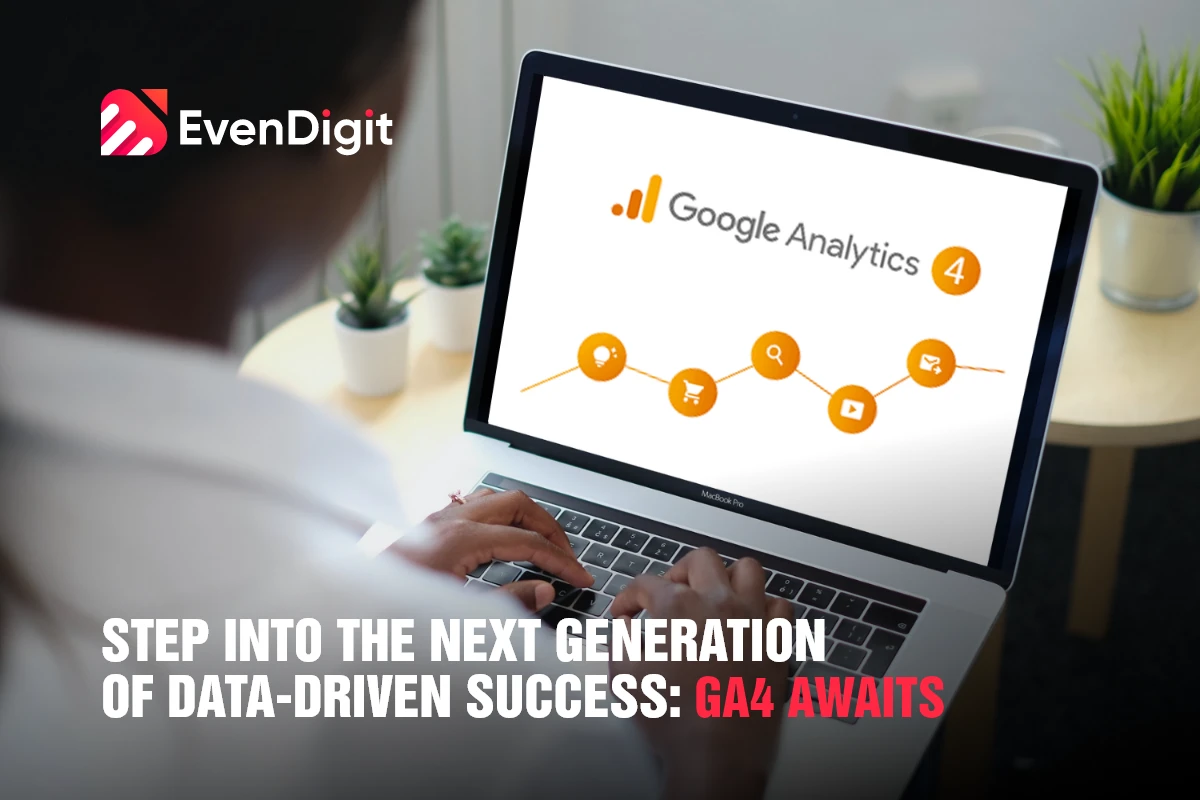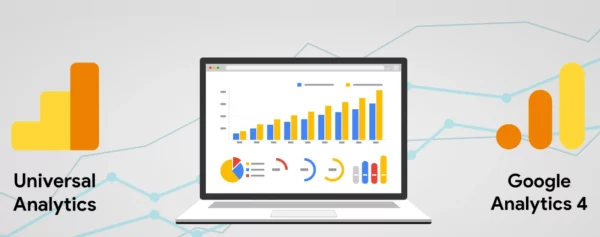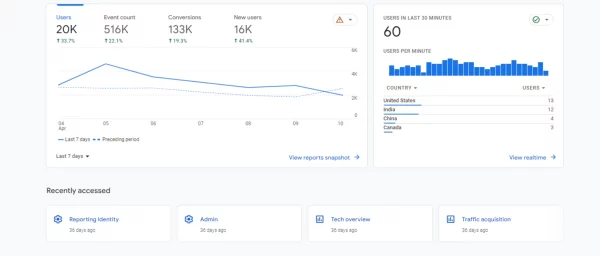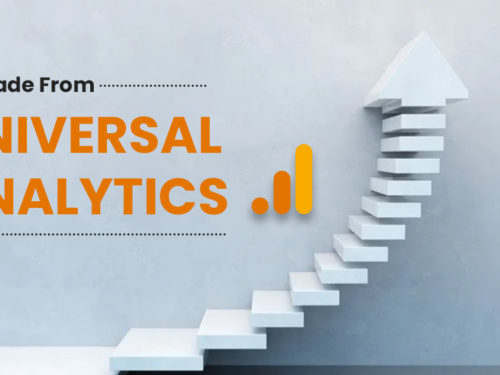
Sometimes, we all find it challenging to analyze and interpret data, hindering our ability to fully tap into its potential. But until when? Because it is crucial for a business’s success to tap into the power of data as the digital landscape evolves.
Also, it is truly said, “Without data, you’re just another person with an opinion.” – W. Edwards Deming.
So, to up your analytics game and boost your business with the power of data, let’s unveil the update.
Say hello to GA4 and Goodbye to Universal Analytics!
The latest and greatest version of Google Analytics, GA4, offers advanced features and capabilities. Let’s explore and evolve more!
Exploring the World of Google Ads
Google Ads is an online advertising platform that allows businesses to display ads on Google’s search results pages, YouTube, and other partner websites.
Businesses can target specific audiences and drive website traffic by bidding on keywords related to their products or services.
The platform uses a pay-per-click (PPC) model, where advertisers only pay when users click on their ad.
What Sets GA4 Apart?
Are you ready to take your digital marketing game up? Look no further than GA4 – the latest and greatest in web analytics technology.
Here are just a few reasons why GA4 sets itself apart from the rest:
1. Mobile-Centric Approach:
We all know that mobile is king when it comes to online interactions. GA4 understands this and has built its platform around a mobile-first approach.
GA4 provides a more accurate and holistic understanding of the customer journey by tracking user interactions across various platforms and devices.
- Let’s say a user starts searching for a new pair of shoes on their phone, then switches to their desktop to make the purchase. With GA4, you’ll be able to see the full picture of their journey and optimize your marketing efforts accordingly.
2. Emphasis on Events:
In GA4, everything is treated as an event. Whether it’s a button click, a page view, or a video play, GA4 tracks it all.
This shift from traditional goals to conversions makes it easier to measure success and optimize campaigns based on user actions.
- For instance, if you’re running an e-commerce store, you can track how many users add items to their cart and how many of them complete the purchase.
3. Data Streams Replace Views:
Say goodbye to views and hello to data streams. GA4 has streamlined the data organization process by managing filtering through Google Tag Manager.
This simplifies capturing and analyzing website and app data, making it easier to get the insights you need.
4. Engaged Sessions Take Center Stage:
GA4 focuses on user engagement rather than page-oriented metrics like bounce rate. GA4 provides a more accurate representation of how users interact with your content by measuring engaged sessions.
- For example, if a user spends 10 minutes on your website scrolling through multiple pages, that’s a strong indicator of engagement. This data allows you to tailor your marketing efforts to your audience’s needs and preferences.
5. Integration with BigQuery:
GA4 is built on Google’s powerful BigQuery platform, providing marketers with improved access to underlying data for querying or integration with tools like Google Data Studio.
This seamless integration allows you to dive deeper into your analytics data, uncovering insights that drive better decision-making and campaign optimization.
- For instance, if you’re running a Google Ads campaign, you can analyze which keywords drive the most traffic to your site and adjust your bidding strategy accordingly.
GA4’s mobile-centric approach, emphasis on events, data stream organization, focus on user engagement, and integration with BigQuery make it a game-changer in web analytics.
Using GA4, you can gain deeper insights into your audience and optimize your marketing efforts to drive better results.
So what are you waiting for? Start using GA4 today and take your digital marketing to the next level!
Interested in Digital Marketing Services? Let’s connect!
What about historical data?
The historical data from Universal Analytics won’t be transferred to GA4. However, Google will continue to provide access to Universal Analytics data until July 1, 2023. It’s crucial to gather data in GA4 as soon as feasible to have a solid dataset for future reference.
The Hurdles of Universal Analytics
Universal Analytics (UA) comes with several limitations that impact its effectiveness:
a) Limited Cross-Device Tracking: UA struggles to track users across multiple devices, resulting in fragmented data and an incomplete understanding of the user journey.
b) Inflexible Data Collection: UA’s data collection capabilities are limited, making it challenging to customize or expand data collection.
c) Outdated Data Model: UA uses a session-based data model, which is less accurate in today’s user-centric digital landscape. This model focuses on individual sessions rather than the overall user experience, which may not provide a complete picture of user behavior.
These limitations negatively impact the tracking of Google Ads performance. Without accurate cross-device tracking, digital marketers may underestimate the effectiveness of their campaigns, leading to suboptimal targeting and budget allocation.
Let’s see how GA4 stands out UA
| Universal Analytics | GA4 | |
|---|---|---|
| Data Model | UA uses a session-based data model, focusing on individual sessions, which might not provide a complete picture of user behavior. It also struggles to track users across multiple devices, leading to fragmented data. | GA4 adopts a user-centric data model, tracking user interactions across various devices and platforms. This approach provides a more holistic and accurate understanding of the customer journey. |
| Event Tracking | In UA, tracking custom events requires complex workarounds and additional code, making it challenging to customize or expand data collection. | GA4 simplifies event tracking by treating everything as an event, allowing for flexible data collection and easy tracking of custom events. |
| Conversion Measurement | UA uses goals to measure conversions, which can be less flexible and harder to set up for specific user actions. | GA4 replaces goals with conversions, streamlining the process of measuring success and optimizing campaigns based on user actions. |
| Metrics Focus | UA relies on page-oriented metrics like bounce rate, which might not accurately represent user engagement. | GA4 focuses on session-based metrics like engaged sessions, providing a better understanding of user interactions and overall user experience. |
GA4 offers a more comprehensive, flexible, and user-centric approach to web analytics, empowering marketers to make data-driven decisions.
GA4 helps marketers optimize their campaigns effectively as compared to Universal Analytics.

Unlocking the Potential of Google Analytics 4
Google Analytics 4 offers numerous benefits that make it a powerful tool for tracking and optimizing Google Ads performance:
1. Enhanced Cross-Device Tracking: GA4’s advanced tracking capabilities provide a more accurate and holistic view of the user journey across multiple devices. For example, if a user discovers your ad on their mobile device and later converts on their desktop, GA4 will track this as a single user journey, allowing you to better understand the effectiveness of your ad targeting and budget allocation, ultimately leading to higher ROI.
2. Event-based Data Collection: GA4 allows for flexible data collection and easy tracking of custom events. For instance, if you want to track when users add items to their shopping carts, GA4 makes it simple to capture this data, providing deeper insights into user behavior and helping marketers understand the specific actions that lead to conversions.
3. AI-driven Insights: GA4 uses artificial intelligence to surface valuable insights and recommendations, such as predicting future user behavior and suggesting optimizations. This empowers marketers to make data-driven decisions and stay ahead of the competition.
4. User-centric Data Model: GA4 offers a more accurate representation of user interactions and the overall user experience by focusing on user behavior rather than individual sessions. This allows marketers to better tailor their campaigns to the needs and preferences of their target audience.

The Importance of Transitioning to Google Analytics 4
Migrating to GA4 is essential for staying ahead in the digital marketing landscape. With its enhanced features and capabilities, GA4 provides superior insights that help Google Ads users make data-driven decisions and optimize their campaigns.
{For example, GA4’s AI-driven insights may suggest that a specific ad creative resonates better with your audience, allowing you to adjust your strategy accordingly.}
Furthermore, Google is expected to phase out Universal Analytics eventually, making the migration to GA4 inevitable. By not migrating, businesses risk missing valuable insights and falling behind competitors already embracing GA4.
The Google Analytics 4 Migration Process
Migrating to GA4 involves several steps:
Step 1: Create a new GA4 property in your Google Analytics account. This will allow you to run both Universal Analytics and GA4 side by side, providing a useful comparison of data and insights.
Step 2: Configure data streams for your website and/or app, ensuring the proper data collection. For example, you may need to set up separate data streams for your desktop and mobile websites to track user behavior across devices accurately.
Step 3: Implement new GA4 tracking codes on your website by updating existing codes or using a tag management system like Google Tag Manager. This will ensure you capture the right data for your GA4 property.
Step 4: Verify data collection and configure necessary settings, such as conversion tracking, audience definitions, and custom events. For instance, you might set up conversion tracking for form submissions, allowing you to measure the success of your lead-generation campaigns.
The migration process can be challenging, but our expert team is here to help. We provide comprehensive support throughout the migration process, ensuring a seamless transition to GA4 and unlocking the full potential of your analytics data.
VII. Final Thoughts
It’s time to start planning and preparing for your move to GA4. Our team is ready to assist you with every step of the migration process, ensuring a smooth transition and empowering your digital marketing efforts.
With GA4, you’ll gain deeper insights into your campaigns, such as understanding which ad creatives drive the most conversions or identifying high-value audience segments. These insights will help you generate leads and drive success for your clients.
You know what they say, “Old analytics never die; they just fade away.” So let’s switch to GA4 and keep your data analysis game alive and strong.
EvenDigit
EvenDigit is an award-winning Digital Marketing agency, a brand owned by Softude (formerly Systematix Infotech) – A CMMI Level 5 Company. Softude creates leading-edge digital transformation solutions to help domain-leading businesses and innovative startups deliver to excel.
We are a team of 70+ enthusiastic millennials who are experienced, result-driven, and hard-wired digital marketers, and that collectively makes us EvenDigit. Read More




